The yellow bird is a common sight in California. The state is home to various beautiful yellow birds, from the bright yellow of the American Goldfinch to the deep gold of the Lesser Goldfinch.
These birds can be seen in almost any habitat, from the lush forests of the north to the deserts of the south. Yellow birds’ brilliant colors and cheerful songs add color and joy to any outdoor experience.
35 Yellow Birds in California
California is a bird lover’s paradise, with over 600 species recorded in the state. Many yellow birds brighten the landscape with their vibrant plumage and cheerful songs.
Here are 35 yellow birds that you can find in California.
1. American Goldfinch
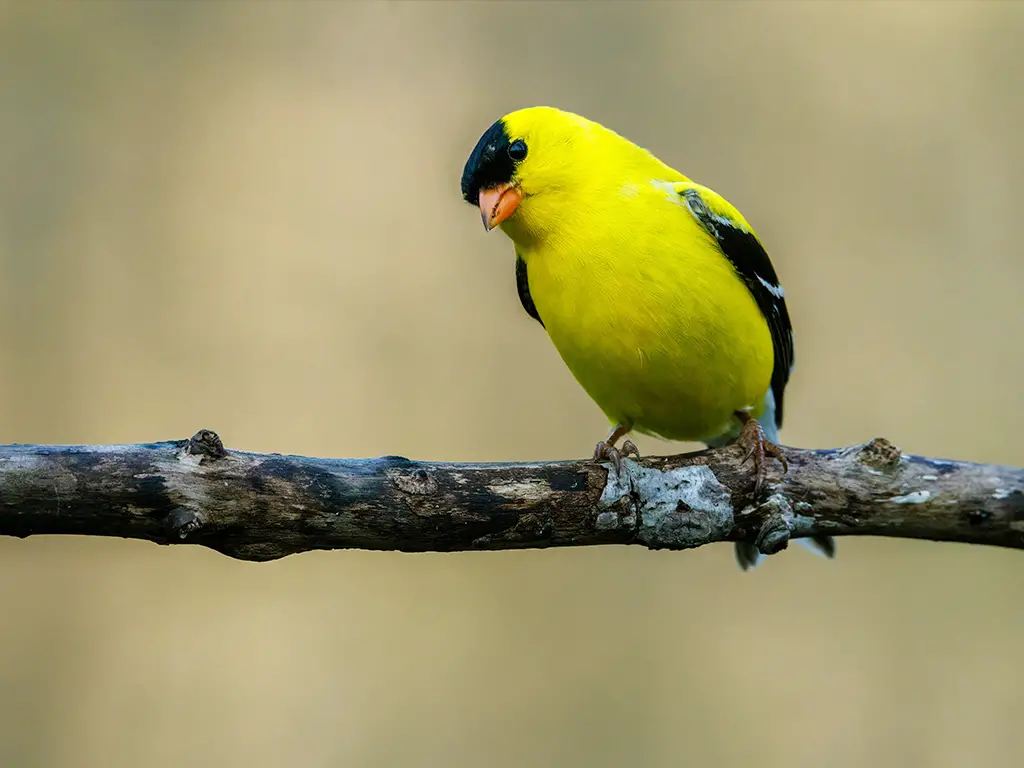
The American goldfinch is a small bird found in North America and belongs to the finch family. It is a migratory species, meaning it travels from one place to another in search of food and better living conditions.
It can be found in mid-Alberta to North Carolina in the summer, while in the winter, it is seen from just south of the Canada-United States border to Mexico.
This is done to find more suitable conditions for survival and usually happens when food sources become scarce, and temperatures get too cold. The American goldfinch is an adaptive species, which has allowed it to survive in a wide variety of climates.
It can adjust to the changing conditions of its environment and make the best of any situation.
| Kingdom | Animalia |
| Phylum | Chordata |
| Clade | Dinosauria |
| Class | Aves |
| Order | Passeriformes |
| Family | Fringillidae |
| Genus | Spinus |
| Species | S. tristis |
2. Yellow Warbler
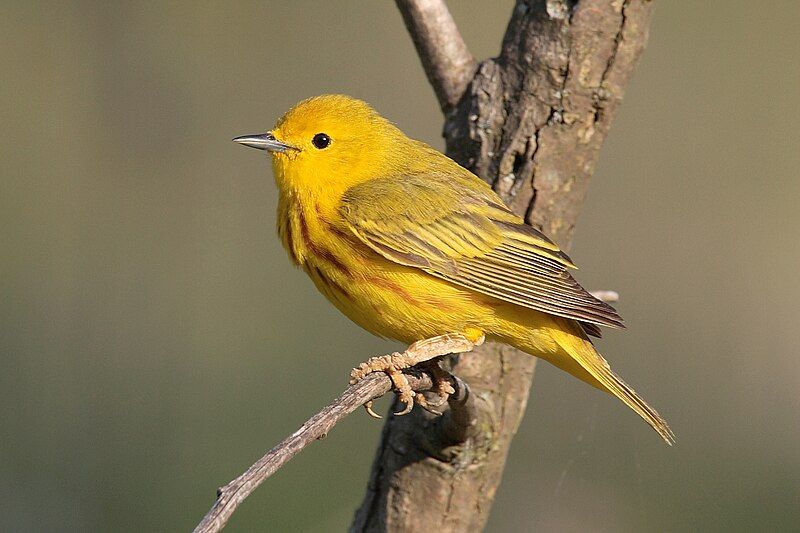
The yellow warbler is a bird species found in the New World. It is part of the genus Setophaga, a diverse bird group. Yellow warblers have an extensive range, breeding in much of North America, the Caribbean, and some parts of northern South America.
This makes them the most widespread species of the Setophaga genus, as their range covers a large geographical area. Yellow warblers are small birds with bright yellow plumage and reddish streaks on their chest. They often inhabit wooded areas, as well as near bodies of water.
They mainly eat insects and larvae but may also eat fruits and berries. During the breeding season, they build compact nests of grass and twigs in shrubs or trees. Yellow warblers are migratory birds who can travel long distances during their migratory journeys.
They may travel as far north as Canada and Alaska during the summer months and south as Central America during the winter months. This is a fantastic feat for such a small bird. The yellow warbler is an important species to the ecosystems in which it lives.
It helps to keep insect populations in check, and its presence is a sign of a healthy environment. It is also a famous bird with birdwatchers who enjoy observing its bright colors and active behavior.
| Kingdom | Animalia |
| Phylum | Chordata |
| Clade | Dinosauria |
| Class | Aves |
| Order | Passeriformes |
| Family | Parulidae |
| Genus | Setophaga |
| Species | S. petechia |
3. New World Warblers
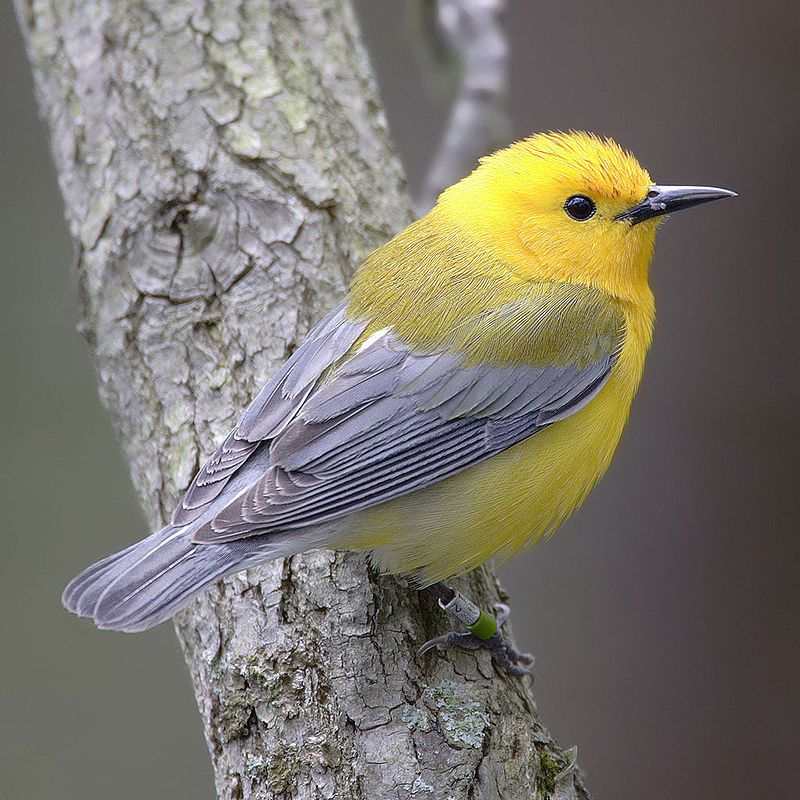
The New World warblers, or wood-warblers, are a family of birds found primarily in the New World, including North and South America. They are small, with many being brightly colored, and are part of the passerine family Parulidae.
They are distinct from the Old World warblers found in Europe, Asia, and Africa, as well as those found in Australia.
These singers have unique characteristics, including their bright colors and small size, that set them apart from other species of birds. The New World warblers are found in various habitats, including temperate and tropical forests, grasslands, and wetlands.
They are also known as wood warblers because they prefer wooded areas.
These birds feed mainly on insects and their larvae but can also eat fruits, berries, and seeds. The New World singers are known for their unique songs, which are used to attract mates and mark their territories.
They also use their songs to communicate with one another, establish dominance among members of their species, and warn of potential predators. The New World warblers are essential to the North American ecosystem, as they help keep insect populations in check.
They also provide an essential source of food for many animals and birds. In addition, their bright plumage and songs make them a famous sight in North American backyards.
| Kingdom | Animalia |
| Phylum | Chordata |
| Clade | Dinosauria |
| Class | Aves |
| Order | Passeriformes |
| Family | Parulidae |
4. Yellow-Rumped Warbler
The yellow-rumped warbler (Setophaga coronata) is a medium-sized songbird in North America. It is a migratory species that breeds in the northern US and Canada and spends the winter months in the southern US and Mexico.
This species regularly visits backyard feeders and can be easily spotted in forests and woodlands during migration. It has a distinctive yellow patch on its back and rump, seen in flight.
This species feeds on insects, berries, and seeds, making it an essential part of the ecosystem. It is an adaptable species that has been able to successfully coexist with human settlements, making it a common sight in cities, towns, and suburbs.
Its presence is a welcome sign of spring, as it is one of the first birds to appear in the spring. The yellow-rumped warbler is an essential species for conservation, as it indicates healthy ecosystems.
| Kingdom | Animalia |
| Phylum | Chordata |
| Clade | Dinosauria |
| Class | Aves |
| Order | Passeriformes |
| Family | Parulidae |
| Genus | Setophaga |
| Species | S. coronata |
5. Yellow-Headed Blackbird
The yellow-headed blackbird is a species of blackbird that stands out from other birds due to its distinctive yellow-colored head. It is a medium-sized bird, usually between seven and eight inches long, with a wingspan of up to fourteen inches.
Its body is mainly black, with white patches on its wings and tail. The yellow head is its most prominent feature, with a black cap and bright yellow feathers.
The bird is found in northern and western North America, from southern Canada to the northern United States. The yellow-headed blackbird is the only species in the genus Xanthocephalus, which makes it a unique species.
It is a solitary bird, usually nesting in marshes and wetlands, and can often be seen perched on trees or fences near its nesting grounds. Its diet consists mainly of insects and other small creatures such as spiders and worms, and it is also known to eat some seeds and fruits.
It is a migratory species, with some individuals traveling up to a hundred miles south in the winter. The yellow-headed blackbird is an essential species in many wetlands, as it helps keep the insect population balanced.
It has even been used in pest control programs in some areas. However, this species is threatened by habitat loss and other human activities. It is also vulnerable to predation by larger birds, such as hawks and owls.
Conservation efforts are being made to protect this species and its habitat and to ensure its continued survival.
| Kingdom | Animalia |
| Phylum | Chordata |
| Clade | Dinosauria |
| Class | Aves |
| Order | Passeriformes |
| Family | Icteridae |
| Genus | Xanthocephalus |
| Species | X. xanthocephalus |
6. Lesser Goldfinch
The lesser goldfinch is a type of small songbird found in the Americas. It is part of a larger clade of species known as the New World goldfinches, which includes the American goldfinch and Lawrence’s goldfinch, all of which are in the genus Spinus.
The males of all three species have one distinguishing characteristic – a black forehead – which is not seen in the females. This black forehead is a unique feature that sets the male lesser goldfinches apart from the females and all other species in the clade.
| Kingdom | Animalia |
| Phylum | Chordata |
| Clade | Dinosauria |
| Class | Aves |
| Order | Passeriformes |
| Family | Fringillidae |
| Genus | Spinus |
| Species | S. psaltria |
7. Yellow-Breasted Chat
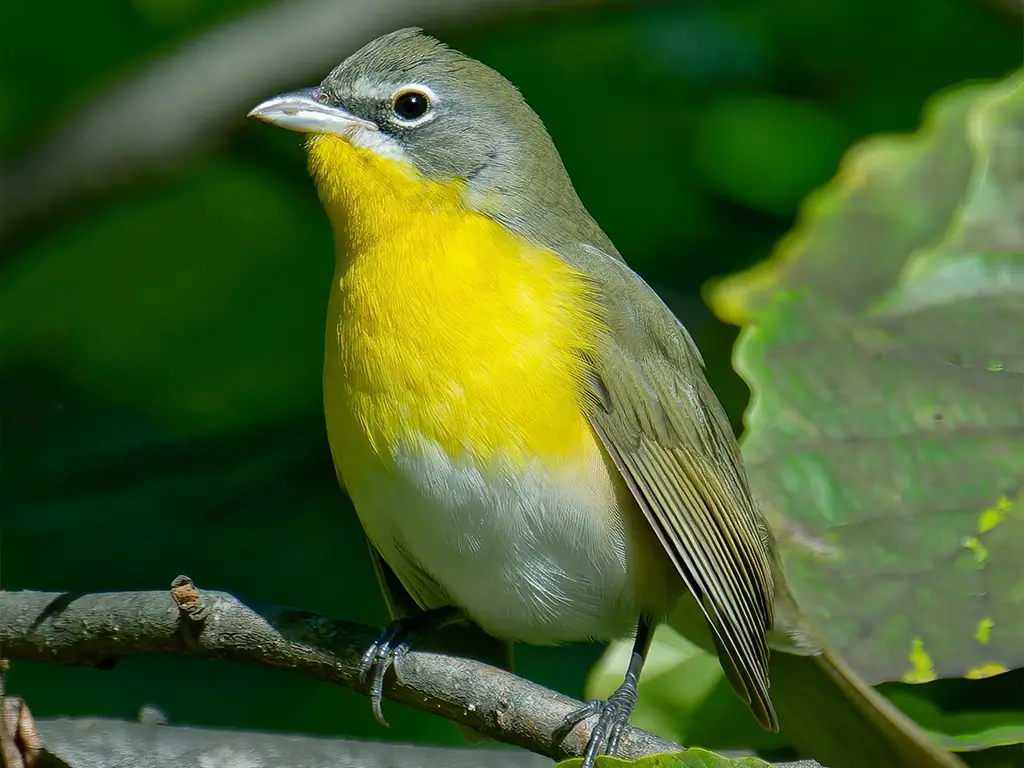
The yellow-breasted chat is a large songbird found in North America and is the only member of the family Icteriidae. This species is unique in its classification, as it was previously placed within the New World warbler family.
However, in 2017, the American Ornithological Society moved the yellow-breasted chat to its family, even though its placement was resolved.
This change in classification reflects the growing understanding of the evolutionary relationships among different bird species.
The yellow-breasted chat is not a typical warbler, and thus, it has been reclassified into its own family, the Icteriidae.
This family contains only the yellow-breasted chat and is not closely related to any other bird family. All researchers have not accepted this new classification, and there is still much debate about the best placement for the yellow-breasted chat.
Some suggest that the species should be placed within the warbler family, while others believe it should remain in its own family.
Until a definitive conclusion is reached, the yellow-breasted chat will remain in its family. The yellow-breasted chat is an interesting species, and its classification continues to be a source of debate among ornithologists.
Although its placement is still not definitively resolved, the American Ornithological Society has taken a step toward recognizing this species as a unique and separate entity.
This will allow for more detailed research into the species, which could provide more insight into its evolutionary relationships with other birds.
| Kingdom | Animalia |
| Phylum | Chordata |
| Clade | Dinosauria |
| Class | Aves |
| Order | Passeriformes |
| Family | Icteriidae |
| Genus | Icteria |
| Species | I. virens |
8. Wilson’s Warbler
Wilson’s warbler is a small bird from the New World warbler family. It is primarily greenish on the upper part of its body, while the lower part is yellow. It has a rounded wingspan and a long, slim tail.
The male of the species has an additional black patch on its crown, though the size and shape of this patch may vary according to the subspecies. The female of the species either has a reduced version of the black patch or may be absent entirely.
| Kingdom | Animalia |
| Phylum | Chordata |
| Clade | Dinosauria |
| Class | Aves |
| Order | Passeriformes |
| Family | Parulidae |
| Genus | Cardellina |
| Species | C. pusilla |
9. Western Tanager

The western tanager is a medium-sized songbird native to America. It was initially classified as a member of the tanager family, but it and its close relatives are now grouped with the cardinal family.
This is because the western tanager has physical features and behaviors similar to other cardinal family members. Its plumage, feathers, vocalizations, and sounds are characteristic of species within the cardinal family.
Its overall shape and size also align with other birds of the cardinal family. This similarity between the western tanager and members of the cardinal family is why it has been reclassified to this family.
| Kingdom | Animalia |
| Phylum | Chordata |
| Clade | Dinosauria |
| Class | Aves |
| Order | Passeriformes |
| Family | Cardinalidae |
| Genus | Piranga |
| Species | P. ludoviciana |
10. Common Yellowthroat
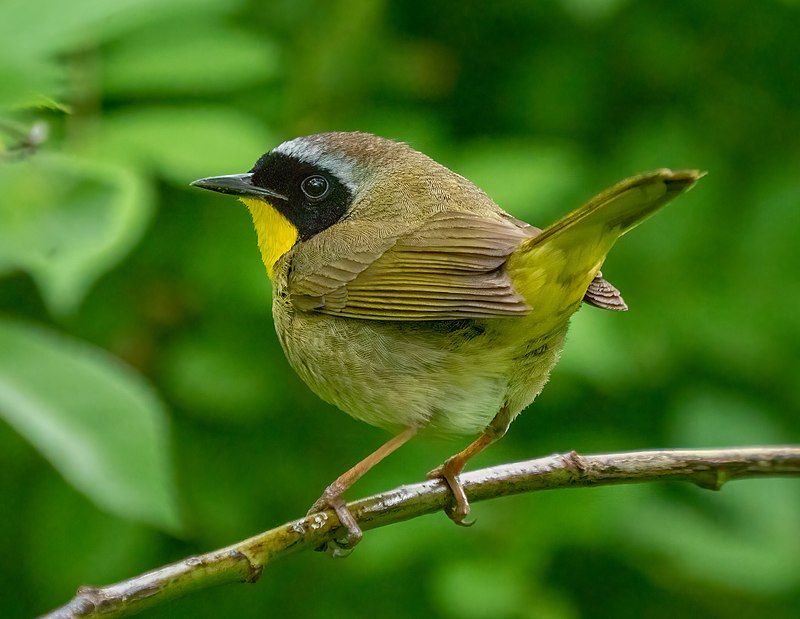
The common yellowthroat is a New World warbler widely distributed throughout North America. It is also known as the yellow bandit or Maryland yellow-throat and is an abundant breeder in the region.
Its range stretches from southern Canada in the north down to central Mexico in the south. This warbler species prefers wetlands, such as marshes, swamps, and wet meadows, and can be found in shrubby fields, thickets, and woodlands near water.
The male common yellowthroat is easily identifiable by its bright yellow throat, olive-green back, and a black mask over its eyes. It has a distinctive call that sounds like “witchy-witchy-witchy.” This call is used to ward away other birds and to attract a mate.
The female common yellowthroat is duller in color than the male, with a yellow throat, olive-green back, and white underparts. Both sexes feed mainly on insects, spiders, and other small invertebrates.
The common yellowthroat is a famous backyard bird found in many residential areas.
| Kingdom | Animalia |
| Phylum | Chordata |
| Clade | Dinosauria |
| Class | Aves |
| Order | Passeriformes |
| Family | Parulidae |
| Genus | Geothlypis |
| Species | G. trichas |
11. Icterids
Icterids, or New World blackbirds, are a family of birds known as Icteridae. These birds range in size from small to medium and are pretty colorful. The predominant color of the plumage of these birds is black, but they are often enlivened by yellow, orange, or red.
Each species of the family is different in terms of size, shape, behavior, and color. For example, some may be smaller and more colorful, while others may be larger and plainer. They also vary in behavior, with some being more active than others.
Each species has unique characteristics and coloration, making them a fascinating group of birds to observe.
| Kingdom | Animalia |
| Phylum | Chordata |
| Clade | Dinosauria |
| Class | Aves |
| Order | Passeriformes |
| Family | Icteridae |
12. Hooded Oriole

The Hooded Oriole is a species of bird found in the New World. It is medium-sized, and the males of the species have a vibrant range of colors, ranging from a bright orange to a paler yellow. It has a black back, face, tail, and bib, with two white bars on the wings.
The female of the species is more of an olive color, with some yellow accents. The Hooded Oriole is an attractive bird species popular amongst bird watchers. Its plumage is unique and sets it apart from other species of oriole.
It is a fascinating bird, with its bright colors and distinct markings. It is an excellent addition to any backyard and can be found in many parts of the United States.
| Kingdom | Animalia |
| Phylum | Chordata |
| Clade | Dinosauria |
| Class | Aves |
| Order | Passeriformes |
| Family | Icteridae |
| Genus | Icterus |
| Species | I. cucullatus |
13. Western Meadowlark
The western meadowlark is a medium-sized icterid bird, measuring approximately 8.5 inches. It is native to west and central North America and prefers to nest in open grasslands.
Its diet consists primarily of insects but will also feed on seeds and berries. The western meadowlark is well-adapted to its natural habitat. Its long, pointed beak is perfectly designed for probing the ground for insects and other small prey.
Its yellow breast and wings are camouflaged to blend in with its home range’s tall grasses and meadows. The western meadowlark is also capable of flight and uses this skill to escape predators or seek new quick food sources.
The western meadowlark is a famous sight in North America, and its cheerful song can often be heard during the day. It symbolizes joy and freedom, as its song often carries across fields and meadows in its range.
The western meadowlark is an essential species in the ecosystems it inhabits, as it helps to keep the population of insects and other small prey in check.
The western meadowlark is a fantastic creature, and its presence in open grasslands is an integral part of the rich biodiversity of North America.
| Kingdom | Animalia |
| Phylum | Chordata |
| Clade | Dinosauria |
| Class | Aves |
| Order | Passeriformes |
| Family | Icteridae |
| Genus | Sturnella |
| Species | S. neglecta |
14. Townsend’s Warbler
Townsend’s warbler is a species of bird that is found in areas of North America. It is a small bird, typically measuring 4.5 to 5.5 inches. The bird is a New World warbler family member, which includes more than 50 species of colorful, small songbirds.
Townsend’s warbler is easily identified by its bright yellow underside, gray-brown back, and white throat. It also has a distinctive white eye ring, which helps to distinguish it from other warbler species.
The Townsend’s warbler is found in various habitats, including woodlands, meadows, and marshes. It primarily feeds on insects, which it finds by foraging in trees and shrubs.
During the breeding season, Townsend’s warbler builds its nest in the trees and shrubs of its habitat, typically laying three to five eggs.
This species of warbler is considered to be of least concern in terms of conservation status due to its wide range and stable population.
| Kingdom | Animalia |
| Phylum | Chordata |
| Clade | Dinosauria |
| Class | Aves |
| Order | Passeriformes |
| Family | Parulidae |
| Genus | Setophaga |
| Species | S. townsendi |
15. Western Kingbird
The western kingbird is a species of tyrant flycatcher found in various habitats in western regions of North America. It is a large bird, with males reaching a length of approximately 21 cm and a wingspan of 36 cm.
Its plumage is primarily greyish-brown, with white underparts, a black tail, and a chestnut patch on its back. It is a migratory bird, typically breeding in the warmer months in areas of North America ranging from Alaska to Mexico.
Its diet consists mainly of insects, which it catches in mid-air or from branches and twigs. It has various calls, some of which are used to communicate with its mate or warn other birds of danger.
The western kingbird is an integral part of the food chain in its habitat, providing a food source for larger predators such as hawks and owls.
| Kingdom | Animalia |
| Phylum | Chordata |
| Clade | Dinosauria |
| Class | Aves |
| Order | Passeriformes |
| Family | Tyrannidae |
| Genus | Tyrannus |
| Species | T. verticalis |
16. Palm Warbler
The palm warbler is a small, brightly colored songbird part of the New World warbler family. This species of bird is found across much of North America and winters in the southern United States, Central America, and the Caribbean.
The males have bright yellow coloring on their breasts and faces, while the females are more muted.
They are often seen foraging for insects and seeds on the ground. The palm warbler is a year-round resident in many parts of its range, but some individuals will migrate south for the winter.
They have a distinctive call that often spoke a “dee-dee-dee” or “tsee-tseesee-see-see,” usually before the male arrives in its breeding grounds—the palm warbler breeds in open woodlands, especially near water.
Its diet consists mainly of insects, spiders, and wild fruits. They are often seen in flocks during migration and foraging for food. The palm warbler is an essential species for research and conservation.
It is a species that can be used to study bird population trends and migratory patterns. By monitoring these trends, conservationists can better understand bird populations, migratory patterns, and any potential threats the species might face.
| Kingdom | Animalia |
| Phylum | Chordata |
| Clade | Dinosauria |
| Class | Aves |
| Order | Passeriformes |
| Family | Parulidae |
| Genus | Setophaga |
| Species | S. palmarum |
17. Evening Grosbeak

The evening grosbeak is a passerine bird from the finch family of Fringillidae and is found in North America. It is a relatively large bird with a thick body and a short tail. Its most distinctive feature is its enormous bill.
The evening grosbeak is placed in the genus Hesperiphona, a group of finches closely related to each other. These birds usually inhabit coniferous forests, and they are known for their bright yellow and white plumage.
They feed mainly on fruits, buds, and insects. The evening grosbeak is a social bird, and it is often found in flocks of up to 20 individuals. They breed during the spring and summer, and their nests are usually built in trees or bushes.
The female lays three to four eggs at a time, and she is the one who incubates them. After hatching, the male and female both feed and care for their young.
The evening grosbeak is an integral part of the North American avifauna, and its populations have been stable in most areas over the past few decades.
| Kingdom | Animalia |
| Phylum | Chordata |
| Clade | Dinosauria |
| Class | Aves |
| Order | Passeriformes |
| Family | Fringillidae |
| Genus | Hesperiphona |
| Species | H. vespertina |
18. Cedar Waxwing
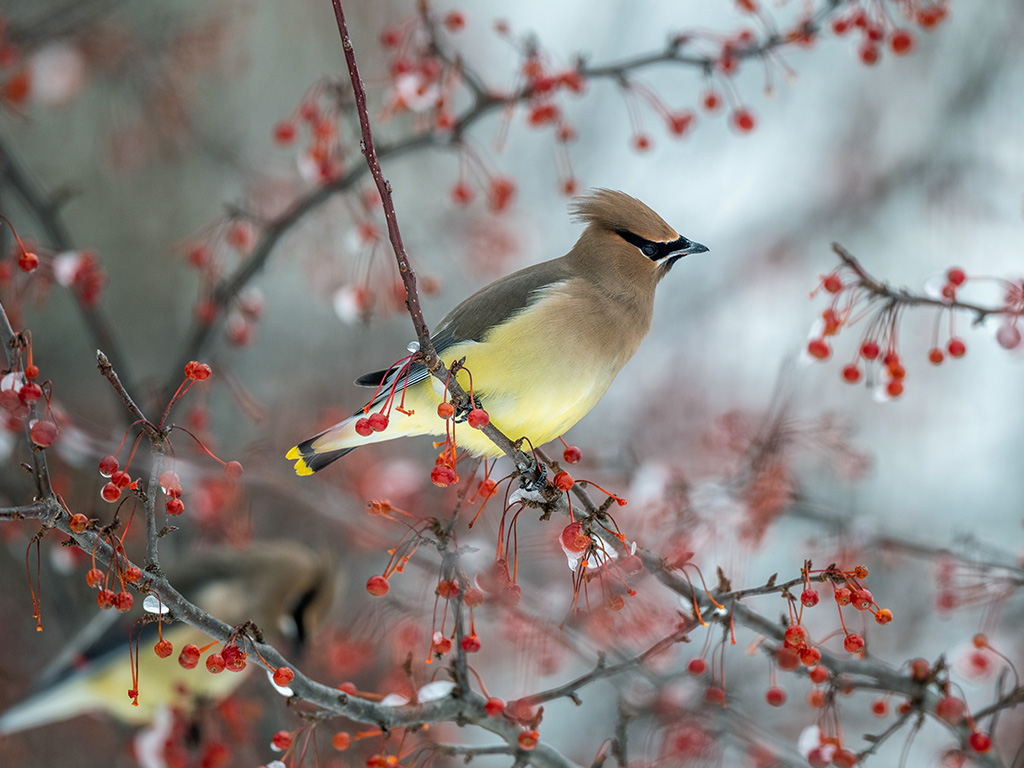
The cedar waxwing is a small passerine bird found in many parts of the world. It is a member of the Bombycillidae family, commonly known as the waxwing family. The bird is approximately the size of a sparrow and is identified by its mostly brown, gray, and yellow feathers.
The name waxwing comes from the wax-like tips of its wings, which are a distinguishing feature. The cedar waxwing is found in many parts of North America, often in open woodlands and other habitats where fruit-bearing trees are present.
It feeds on fruit, insects, and berries and has a unique call that can often be heard in the late summer and early fall. The cedar waxwing is a unique and exciting bird, and its wax-like wing tips make it stand out among other species.
| Kingdom | Animalia |
| Phylum | Chordata |
| Clade | Dinosauria |
| Class | Aves |
| Order | Passeriformes |
| Family | Bombycillidae |
| Genus | Bombycilla |
| Species | B. cedrorum |
19. Macgillivray’s Warbler
MacGillivray’s warbler is a species of New World warbler, a type of songbird. Their sluggish and heavy behavior characterizes them. They tend to be more passive than other species of warblers, as they prefer to spend most of their time on or near the ground.
This contrasts with other singers, which are more active and fly more often in search of food. MacGillivray’s warbler is an exception regarding their behavior, as they are more likely to stay in one place.
The only time they are known to be more active is when singing. This singing activity is primarily done for mating and territorial purposes.
The MacGillivray’s warbler is an exciting songbird species, as their behavior is quite different from that of many other birds and warblers.
| Kingdom | Animalia |
| Phylum | Chordata |
| Clade | Dinosauria |
| Class | Aves |
| Order | Passeriformes |
| Family | Parulidae |
| Genus | Geothlypis |
| Species | G. tolmiei |
20. American Redstart
The American redstart is a small bird species found in the New World. It is a member of the warbler family known for its distinctive bright red and black feathers.
It is unrelated to its namesake, the Old World redstart, a flycatcher species found in Europe and Asia.
The American redstart is found across the United States and parts of Mexico and Canada. It is known for its unique vocalizations and habit of darting out after insects while in flight.
While the American redstart and Old World redstart share a common name, they are two separate and unrelated species.
| Kingdom | Animalia |
| Phylum | Chordata |
| Clade | Dinosauria |
| Class | Aves |
| Order | Passeriformes |
| Family | Parulidae |
| Genus | Setophaga |
| Species | S. ruticilla |
21. Scott’s Oriole
The Scott’s Oriole is a species of icterid, an order of birds characterized by their bright colors and long tails. It’s native to the Southwestern United States, ranging from California to Baja California Sur and central Mexico.
It’s widespread in Sacramento and other parts of southern California. The species was first scientifically described by French ornithologist Charles Lucien Bonaparte in 1838, who gave it the scientific name Icterus parisorum.
The Scott’s Oriole is medium-sized, with a length of around 8 inches. It has an olive-green back, wings, a bright yellow body, and a face. The outermost tail feathers are black, and the males have a black bib. The bird’s song is described as a series of whistles and trills.
It feeds on both insects and fruits and often visits bird feeders. The Scott’s Oriole is a pretty adaptable species, and it can be found in various habitats. It prefers open woodlands but can also be found in parks, gardens, and desert areas.
It is a migratory species, traveling south in the winter and returning north in the spring. The Scott’s Oriole is an overall successful species, though it is threatened by habitat loss due to urbanization and agriculture.
The International Union for Conservation of Nature lists it as a species of most minor concern. Despite this, conservation efforts are still needed to ensure the species’ continued survival.
| Kingdom | Animalia |
| Phylum | Chordata |
| Clade | Dinosauria |
| Class | Aves |
| Order | Passeriformes |
| Family | Icteridae |
| Genus | Icterus |
| Species | I. parisorum |
22. Yellow-Throated Warbler
The yellow-throated warbler is a small songbird species belonging to the New World warbler family. It is found in temperate regions of North America and is a migratory species.
It is a small bird, typically with a length of around 4.7 inches and a wingspan of around 7.5 inches. It is most easily distinguished by its bright yellow throat, which stands out against its otherwise grey plumage.
Additionally, it has a prominent white eyering and a black mask that extends across its face. The yellow-throated warbler can be found in various habitats, including woodlands, shrublands, and marshes.
Its diet is mainly insectivorous, consisting primarily of small insects such as beetles, ants, and spiders. During migration, it may supplement its diet with fruits and berries.
The species is of minor concern, but its population is declining due to losing its natural habitats. Conservation efforts have, therefore, been put in place to ensure the survival of this species.
| Kingdom | Animalia |
| Phylum | Chordata |
| Clade | Dinosauria |
| Class | Aves |
| Order | Passeriformes |
| Family | Parulidae |
| Genus | Setophaga |
| Species | S. dominica |
23. Magnolia Warbler
The magnolia warbler is a songbird species found in North America. It is a small bird, approximately 5 inches long and with a wingspan of about 8 inches. It is a colorful bird with a yellow breast, chestnut flanks, and a white belly.
The males have striking black masks and white eyebrows, while the females have yellow eyebrows and no black mask. The magnolia warbler belongs to the wood warbler family, Parulidae, which includes over 100 species of birds.
These birds are generally found in wooded habitats such as forests and brushy areas and are insectivorous, meaning they primarily feed on insects. The magnolia warbler is an active species, often seen foraging in shrubs and trees for food.
It is a migratory species, breeding in the northern parts of North America and wintering in the southern parts of the continent. The magnolia warbler is a famous bird among birdwatchers and is often seen in gardens, parks, and other green spaces.
Its song is sweet, musical, and a joy to hear. Its bright colors and active behavior make it a favorite among birders.
| Kingdom | Animalia |
| Phylum | Chordata |
| Clade | Dinosauria |
| Class | Aves |
| Order | Passeriformes |
| Family | Parulidae |
| Genus | Setophaga |
| Species | S. magnolia |
24. Hooded Warbler
The Hooded Warbler is a species of bird that is a part of the New World Warbler family. This particular species is found breeding in the eastern part of North America, ranging from the United States to southern Canada.
It is migratory, which means that during the winter, it moves south for warmer climates, going to places in Central America and the West Indies.
Besides its normal range, the Hooded Warbler is considered a scarce vagrant in Western Europe, meaning that it is found there but only in sporadic instances.
| Kingdom | Animalia |
| Phylum | Chordata |
| Clade | Dinosauria |
| Class | Aves |
| Order | Passeriformes |
| Family | Parulidae |
| Genus | Setophaga |
| Species | S. citrina |
25. Lawrence’s Goldfinch
Lawrence’s goldfinch is a small bird species known for its erratic distribution pattern. It is found in several regions, with a breeding range centered in California and Baja California.
This species is known to migrate, as it winters in the southwestern United States and northern Mexico. Its migratory behavior is not well understood but is thought to be driven by the availability of its food sources.
During the summer, Lawrence’s goldfinch feeds primarily on grasses and other plants, including thistles, and during the winter, it switches to seeds from trees and shrubs.
| Kingdom | Animalia |
| Phylum | Chordata |
| Clade | Dinosauria |
| Class | Aves |
| Order | Passeriformes |
| Family | Fringillidae |
| Genus | Spinus |
| Species | S. lawrencei |
26. Canada Warbler
The Canada warbler is a small, brightly colored bird that belongs to the New World warbler family. It is found in North America and is known for its bright yellow and olive-green plumage.
It has a distinctive song that is heard during the summer months in Canada and the northeastern United States. During the winter, the Canada warbler migrates to northern South America, where it can be found in tropical forests and woodlands.
The species is listed as “vulnerable” on the IUCN Red List, making conservation efforts for this species of particular importance. Its habitat is threatened by deforestation, leading to a decrease in population numbers.
Canada warblers feed mainly on insects and other invertebrates, which they glean from the leaves and branches of trees. They are known to be particularly fond of caterpillars.
Conservation efforts for the Canada warbler focus on protecting its habitat and restoring areas of forest that have been lost.
| Kingdom | Animalia |
| Phylum | Chordata |
| Clade | Dinosauria |
| Class | Aves |
| Order | Passeriformes |
| Family | Parulidae |
| Genus | Cardellina |
| Species | C. canadensis |
27. Baltimore Oriole

The Baltimore oriole is a blackbird species commonly found in eastern North America. It migrates to this area during breeding season. The bird derives its name from the resemblance of the male’s colors to those of the coat-of-arms of 17th-century Lord Baltimore.
The Baltimore oriole is an icterid, a type of blackbird that includes the grackle, cowbird, and meadowlark species. Its colors are striking, with blackheads, wings, tails, and bright orange bodies and wings.
The male’s colors are similar to those seen on the coat-of-arms of Lord Baltimore, who was a prominent figure in 17th-century England. The Baltimore oriole is a beloved species, with its bright colors and melodic song.
It is a frequent visitor to many backyards throughout the eastern United States and is an integral part of the local ecology.
| Kingdom | Animalia |
| Phylum | Chordata |
| Clade | Dinosauria |
| Class | Aves |
| Order | Passeriformes |
| Family | Icteridae |
| Genus | Icterus |
| Species | I. galbula |
28. Dickcissel
The Dickcissel is a small bird that belongs to the Cardinalidae family. It is a migratory bird that feeds on seeds and can be found in the Midwestern United States prairie grasslands.
During winter, it migrates to Central America, Northern Colombia, and Northern Venezuela. This bird species is an integral part of the prairie grassland ecosystem in the Midwestern United States.
It is known to eat different types of seeds, which helps to disperse the seeds and promote the growth of new vegetation in the area. Additionally, it also plays a role in pollination, which helps maintain the grasslands’ health.
The Dickcissel is an integral part of the migratory bird population in the United States, and it is essential to conservation efforts to protect the species.
| Kingdom | Animalia |
| Phylum | Chordata |
| Clade | Dinosauria |
| Class | Aves |
| Order | Passeriformes |
| Family | Cardinalidae |
| Genus | Spiza |
| Species | S. americana |
29. Tropical Kingbird

The tropical kingbird is a large tyrant flycatcher species found across a large geographical area. It is native to the United States, from southern Arizona to the lower Rio Grande Valley of Texas.
Additionally, the bird is found across Central and South America, south to central Argentina and eastern Peru. The tropical kingbird is also present in Trinidad and Tobago. The tropical kingbird is a medium-sized bird measuring up to 8 inches long.
Its coloring is distinctive, with a grayish-olive head and back and a yellow belly and tail. The wings and tail are also tipped with black and white. Males and females are very similar in appearance, though males typically have a brighter yellow coloration.
This species of tyrant flycatcher is found in open woodlands, savannas, and other habitats with a mix of trees and shrubs, as well as urban areas. They typically forage for insects from prominent perches, such as the tops of trees, wires, and fence posts.
When feeding, they often hover in the air and snatch flying insects. The tropical kingbird is a monogamous species, with pairs forming strong bonds lasting several years. They build a cup-shaped nest in a tree or shrub, usually near the tip of a branch.
The female typically lays two to four eggs, which both parents incubate for about two weeks. The young fledge after about three weeks. The tropical kingbird is an essential species in its range, as it helps to control insect populations.
It is not currently considered threatened, and its population is stable. However, it is still essential to conserve its habitat and ensure that it is not disturbed by human activities.
| Kingdom | Animalia |
| Phylum | Chordata |
| Clade | Dinosauria |
| Class | Aves |
| Order | Passeriformes |
| Family | Tyrannidae |
| Genus | Tyrannus |
| Species | T. melancholicus |
30. Northern Flicker

The northern flicker, or familiar flicker, is a type of woodpecker native to various countries and regions. It is found in most of North America and parts of Central America, Cuba, and the Cayman Islands.
This bird is considered medium-sized compared to other woodpecker species and is one of the few migrating species. The northern flicker is a distinctive bird with a gray-brown back, spotted with black circles and a white rump.
Their undersides are white, with a black neck and chest. They have a red crescent-shaped patch on their chest, as well as a black stripe on their cheeks.
The northern flicker also has a large, brown-black bill that loud, repeated calls can identify. These birds feed on the ground, eating ants, beetles, and other insects. They use their substantial bills to dig the ground, uncovering their prey.
Northern flickers also eat fruits, berries, and nuts and are known to glean food from trees and shrubs.
They nest in tree cavities, and males and females work together to build their nests. The northern flicker is an integral part of our ecosystems, as it helps to keep insect populations in check.
They also play an essential role in seed dispersal, helping to spread the seeds of trees and shrubs throughout their range.
Additionally, they provide food for predators like owls, hawks, and falcons. The northern flicker is an important species, and its migratory habits help to ensure its survival.
As the northern flicker ranges across such a wide area, it is essential to ensure its habitats and populations remain healthy. The northern flicker is an important species, and its continued survival is vital to our ecosystems.
| Kingdom | Animalia |
| Phylum | Chordata |
| Clade | Dinosauria |
| Class | Aves |
| Order | Piciformes |
| Family | Picidae |
| Genus | Colaptes |
| Species | C. auratus |
31. Yellow-Billed Magpie
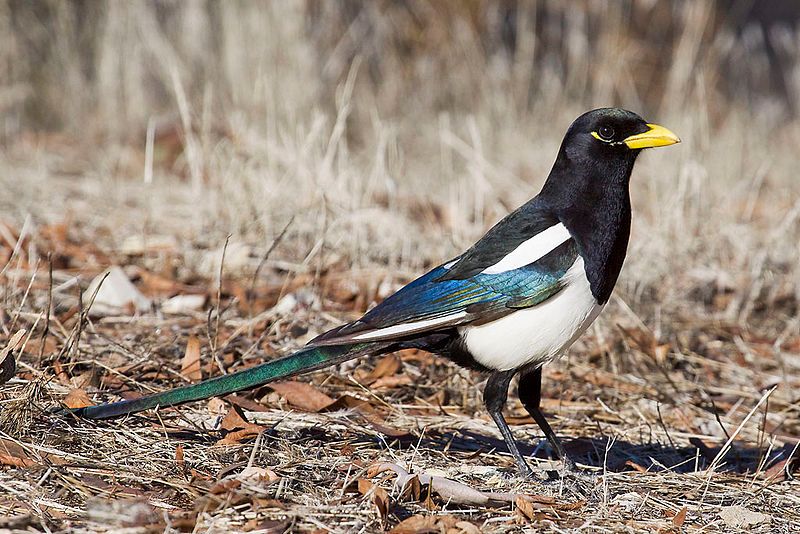
The yellow-billed magpie is a large corvid family bird, including crows, jays, and ravens. It is native to California and is found in the Central Valley and the adjacent chaparral foothills and mountains. It is also known as the California Magpie.
It is characterized by its distinctive yellow bill and long tail, measuring up to 12 inches in length. It is a black and white bird with a black head, neck, upper breast, white wings, belly, and tail.
It feeds mainly on insects, berries, and nuts and is known to scavenge for food. It is a highly social bird, living in small family groups or flocks of up to 50 individuals. It is an essential species in controlling insect populations and dispersing seeds.
It is also a famous bird with birdwatchers due to its striking appearance and ability to be easily observed in its natural habitats.
| Kingdom | Animalia |
| Phylum | Chordata |
| Clade | Dinosauria |
| Class | Aves |
| Order | Passeriformes |
| Family | Corvidae |
| Genus | Pica |
| Species | P. nuttalli |
32. Painted Bunting

The painted bunting is a species of bird found in the cardinal family Cardinalidae, which is native to North America. It is known for its brightly colored plumage, particularly in the males of the species, although this is not visible until the second year of life.
In the first year, it can be difficult to tell the male and female apart, as the male does not yet display the colorful plumage. Only through close inspection can the differences between the two be observed.
The female painted bunting has a duller plumage than the male and can be identified by its grey-green head. The male, however, has a brighter plumage, a yellow head, and a mixture of blue, red, and green feathers.
This spectacular plumage is one of the reasons why the painted bunting is such a famous bird.
| Kingdom | Animalia |
| Phylum | Chordata |
| Clade | Dinosauria |
| Class | Aves |
| Order | Passeriformes |
| Family | Cardinalidae |
| Genus | Passerina |
| Species | P. ciris |
33. Verdin
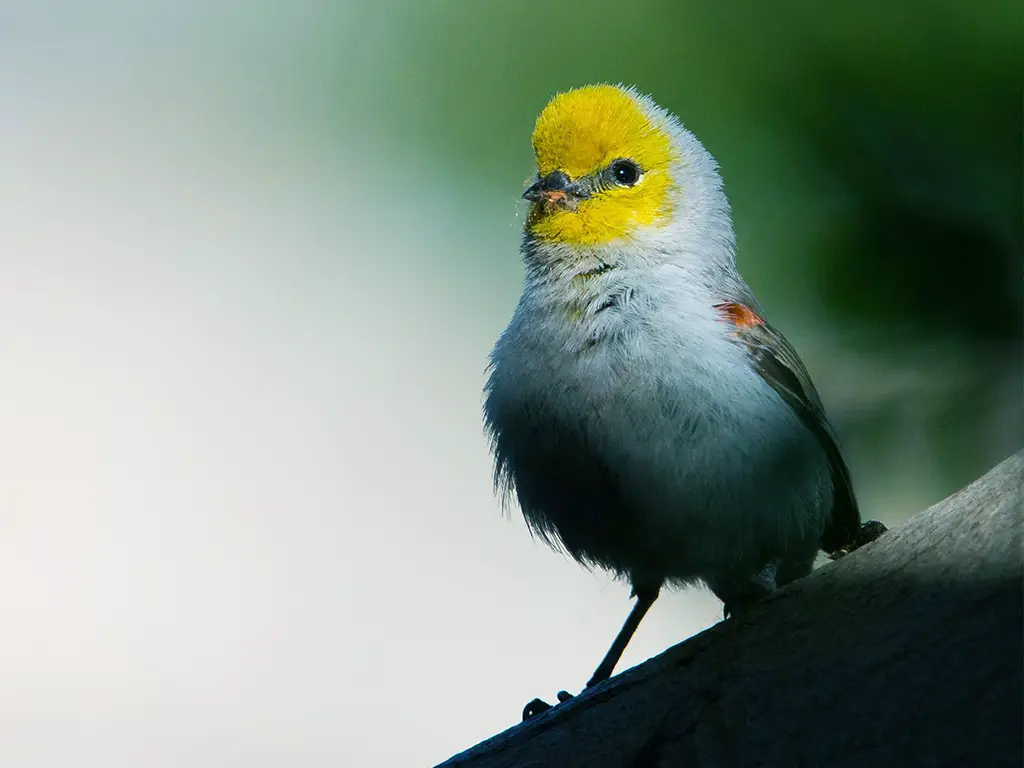
The verdin is a species of penduline tit, a type of small passerine bird. It is a unique species, the only one in its genus, Auriparus.
This species is even more unique, as it only represents the old-world family Remizidae found in North America. This species is widely distributed across the southwestern United States and northern Mexico.
They are usually found in arid habitats such as deserts and chaparral. They feed mainly on insects and build their nests from plant fibers and spider webs. They are known for their cheery song and bright yellow plumage.
The verdin is an exciting species due to its unique range and taxonomic position.
| Kingdom | Animalia |
| Phylum | Chordata |
| Clade | Dinosauria |
| Class | Aves |
| Order | Passeriformes |
| Family | Remizidae |
| Genus | Auriparus |
| Species | A. flaviceps |
34. Yellow-Crowned Night Heron
The yellow-crowned night heron is a species of heron that is found in the Americas. It is one of two species of night heron in the genus Nyctanassa. It is distinct from the black-crowned night heron, which can be found in many places around the globe.
In French, the yellow-crowned night heron is known as the bureau violacé, and in Spanish, it is referred to as the pedigree corona Clara.
This heron species is characterized by its yellow-colored crown and preference to inhabit wetlands and coastal areas within the Americas. It is a medium-sized bird, measuring between 55 and 65 centimeters in length, with a wingspan of 81 to 94 centimeters.
It generally feeds on small fish, frogs, insects, aquatic invertebrates, and some small rodents. The yellow-crowned night heron is listed as a species of most minor concern by the International Union for Conservation of Nature, as its population is stable and widespread.
Nevertheless, protecting its habitats and ensuring its population remains strong is still essential.
| Kingdom | Animalia |
| Phylum | Chordata |
| Clade | Dinosauria |
| Class | Aves |
| Order | Pelecaniformes |
| Family | Ardeidae |
| Genus | Nyctanassa |
| Species | N. violacea |
35. Blue-And-Yellow Macaw
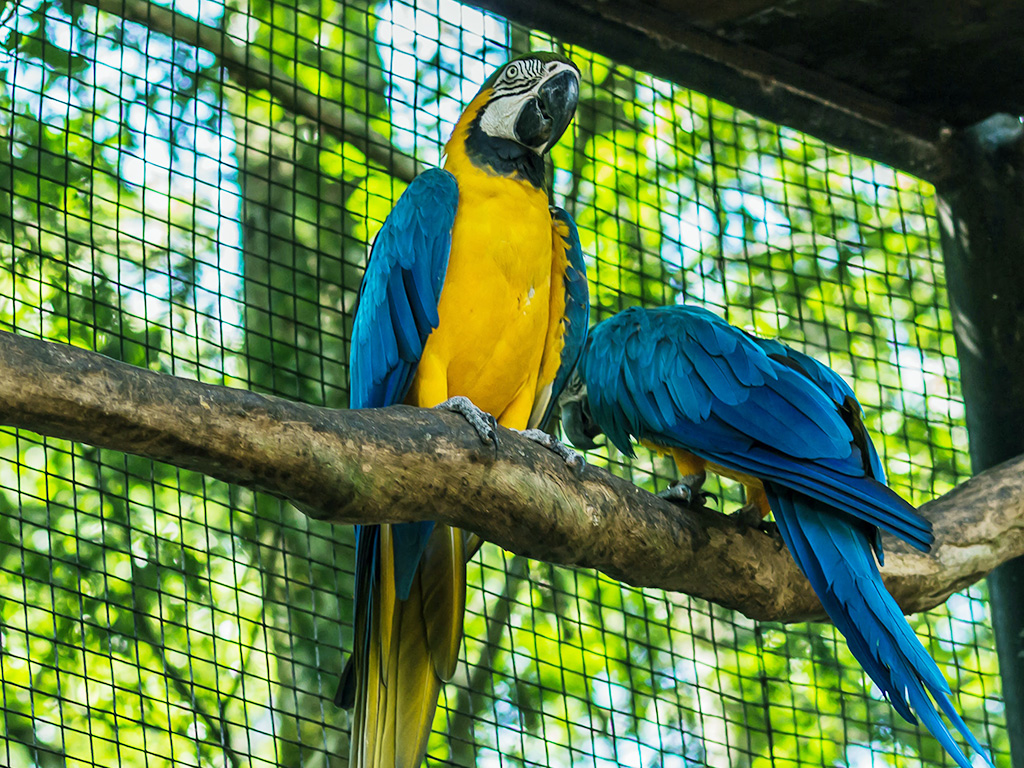
The blue-and-yellow macaw, also known as the blue-and-gold macaw, is a large parrot native to South America. Its bright blue and yellow plumage quickly identifies it. Its back is primarily blue, with a light yellow/orange underside and a gradient of greens on its head.
It belongs to the macaw family, a group of Neotropical parrots. These birds are known for their large size and vibrant colors.
The blue-and-yellow macaw is a popular pet in many countries due to its stunning beauty and intelligence. However, they are increasingly threatened in their native habitat by hunting, trapping, and deforestation.
In recent years, conservation efforts have been enacted to protect these birds, with some success. With continued attention, this species can be protected from further decline.
| Kingdom | Animalia |
| Phylum | Chordata |
| Clade | Dinosauria |
| Class | Aves |
| Order | Psittaciformes |
| Family | Psittacidae |
| Genus | Ara |
| Species | A. ararauna |
Conclusion
The yellow bird population in California is a diverse and vibrant one. They can be found in different habitats across the state, from coastal beaches to montane forests.
The California Department of Fish and Wildlife has identified several species of yellow birds in the state, such as the American goldfinch, western tanager, and yellow-rumped warbler. It is actively engaged in conservation efforts to ensure these birds continue to thrive in California.